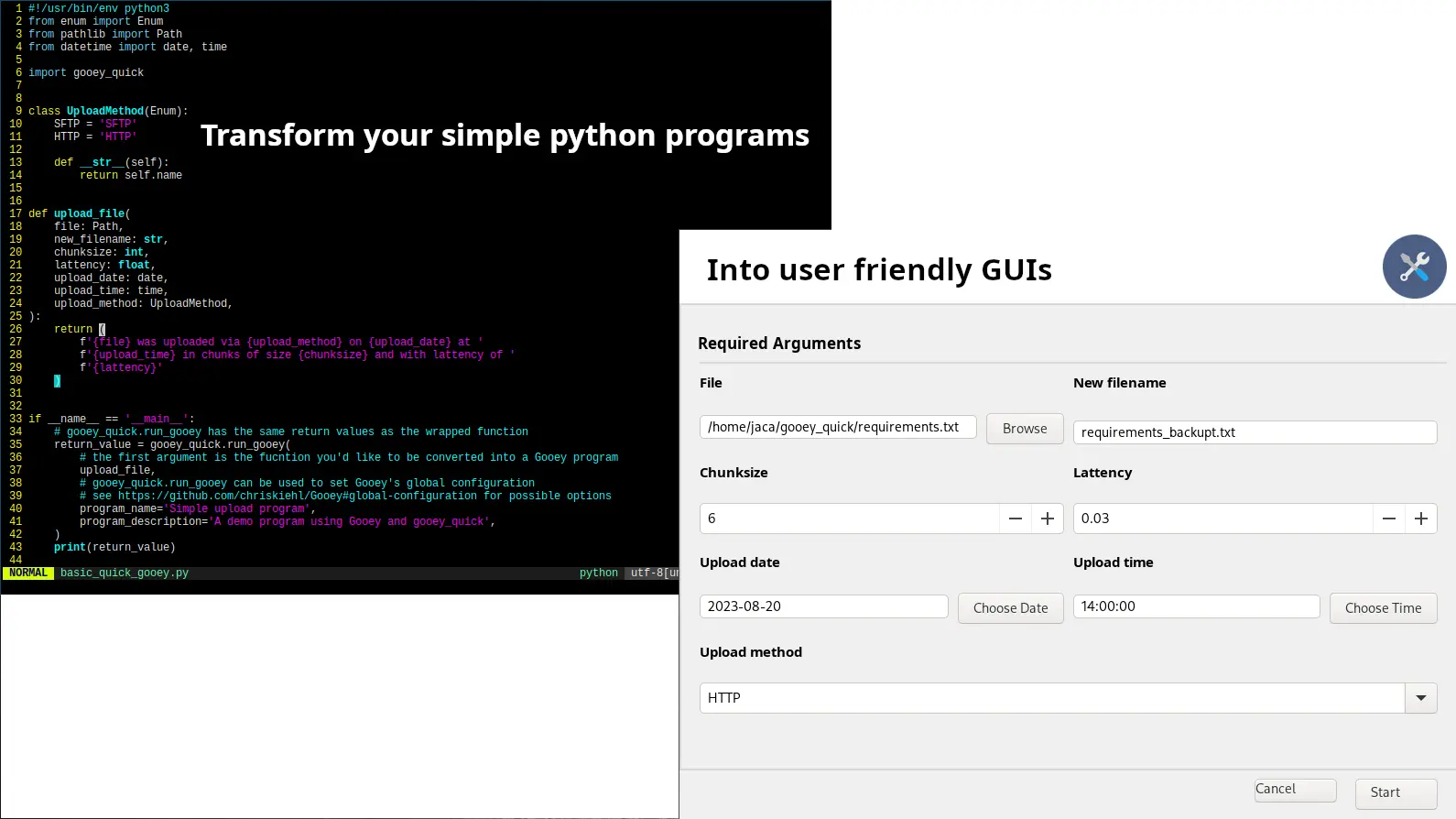Turn type-hinted Python program into a GUI application with few additional lines of code
Project description
gooey-quick
Turn type-hinted Python program into a GUI application with few additional lines of code
Table of contents
Quick Start
Installation
You can install gooey-quick via pip:
pip install gooey-quick
or by cloning the repository directly:
git clone https://github.com/jacadzaca/gooey_quick.git && ./setup.py
Usage
You can integrate gooey-quick with your code as easily as so:
import gooey_quick
def some_function_you_want_to_gooeyfiy(
name: str,
repeat_count: int,
):
for _ in range(repeat_count):
print(f'Hello {name}')
if __name__ == '__main__':
gooey_quick.run_gooey(some_function_you_want_to_gooeyfiy)
Gooey global configuration
You can set Gooey's global options
by setting them in the call to gooey_quick.run_gooey like so:
import gooey_quick
def some_function_you_want_to_gooeyfiy(
name: str,
repeat_count: int,
):
for _ in range(repeat_count):
print(f'Hello {name}')
if __name__ == '__main__':
gooey_quick.run_gooey(
some_function_you_want_to_gooeyfiy,
program_name='Simple demo program',
program_description='A demo program using Gooey and gooey_quick',
)
What is it?
gooey-quick is a library that generates a Gooey-based GUIs from methods' signatures.
Why is it?
A lot of GUI programs that are written in an office setting are wrappers around simple python code. Handcrafting GUIs can be cumbersome, while dealing with argparse-like interface becomes more annoying as the program grows (e.g. you have 6 tabs in your Advanced layout Gooey program). With gooey-quick you should forget about the above and focus on the programs' features.
How does it work?
gooey-quick uses python's built-in typing and introspection functionalities to analyze objects' signatures and generate a fancy GUI using the amazing Gooey by chriskiehl.
Examples
Simple 'Flat layout' application
#!/usr/bin/env python3
from enum import Enum
from pathlib import Path
from datetime import date, time
import gooey_quick
class UploadMethod(Enum):
SFTP = 'SFTP'
HTTP = 'HTTP'
def upload_file(
file: Path,
new_filename: str,
chunksize: int,
lattency: float,
upload_date: date,
upload_time: time,
upload_method: UploadMethod,
):
assert type(upload_method) is UploadMethod
return (
f'{file} was uploaded via {upload_method.name} on {upload_date} at '
f'{upload_time} in chunks of size {chunksize} and with lattency of '
f'{lattency}'
)
if __name__ == '__main__':
# gooey_quick.run_gooey has the same return values as the wrapped function
return_value = gooey_quick.run_gooey(
# the first argument is the fucntion you'd like to be converted into a Gooey program
upload_file,
# gooey_quick.run_gooey can be used to set Gooey's global configuration
# see https://github.com/chriskiehl/Gooey#global-configuration for possible options
program_name='Simple upload program',
program_description='A demo program using Gooey and gooey_quick',
)
print(return_value)
Start Gooey in Advanced mode with 3 different tabs:
#!/usr/bin/env python3
from pathlib import Path
from typing import Optional
from datetime import date, datetime
import gooey_quick
def search_history(
history_file: Path,
wanted_phrase: str,
min_occure_date: Optional[date] = None,
max_occure_date: Optional[date] = None,
) -> Optional[tuple[date, str]]:
occurance_date = date(year=2002, month=7, day=22)
the_phrase = "wow you have discovered my secret phrase!"
occurance_in_range = True
if min_occure_date is not None and max_occure_date is not None:
print(f'Looking for {wanted_phrase} from {min_occure_date} to {max_occure_date}...')
occurance_in_range = occurance_date in range(min_occure_date, max_occure_date)
if wanted_phrase in the_phrase and occurance_in_range:
return f'{occurance_date}: {the_phrase}'
def append_to_history(
history_file: Path,
phrase: str,
occurance_date: date = datetime.now().date()
):
return f'Appending {phrase} to {history_file} at {occurance_date}...'
def remove_from_history(
history_file: Path,
phrase: str,
):
return f'Removing {phrase} from {history_file}...'
if __name__ == '__main__':
# when passing a dict to gooey_quick.run_gooey, the keys become
# the tabs descriptions, while the values are the function to
# create the gui from
return_value = gooey_quick.run_gooey(
{
'Add phrase': append_to_history,
'Remove phrase': remove_from_history,
'Search phrases': search_history,
},
# set Gooey's global config as per: https://github.com/chriskiehl/Gooey#layout-customization
navigation='TABBED',
program_name='Gooey subparser layout from function dict',
program_description='Presents how to create a bundeled configuration with gooey_quick',
)
print(return_value)
For more see the docs/examples/ directory.
Packaging
Please refer to either the official guide or this tutorial
Project details
Release history Release notifications | RSS feed
Download files
Download the file for your platform. If you're not sure which to choose, learn more about installing packages.
Source Distribution
Built Distribution
Hashes for gooey_quick-1.0.1-py3-none-any.whl
| Algorithm | Hash digest | |
|---|---|---|
| SHA256 | fdcee4c14109490df7abc85ff275490140f5bd8bb64916245fdefe88288428e9 |
|
| MD5 | 5f053bc444a1d2d54ef21281c0c9684a |
|
| BLAKE2b-256 | 689f32791b7cece6507b1cfb03155760bdc423642dd4a2b62d7e3057571ed8cd |












